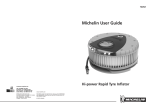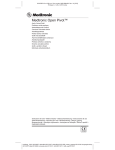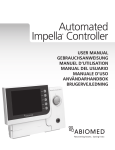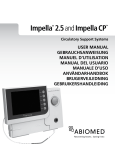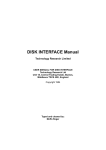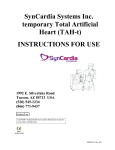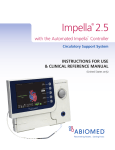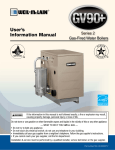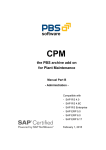Download BVS 5000i Operators Manual
Transcript
ABIOMED® BVS® 5000i BI-VENTRICULAR SUPPORT SYSTEM Operator's Manual CAUTION Federal (U.S.A.) law restricts this device to sale, distribution and use by or on the order of a physician. For use only by personnel trained in accordance with the ABIOMED Training Program. Read all warnings, precautions, and instructions carefully prior to use. Manufactured by: ABIOMED, Inc. 22 Cherry Hill Drive Danvers, MA 01923 USA N. America: 1-800-422-8666 (24-Hour, Emergency Hotline) or (978) 777-5410 Outside N.A.: 01-978-777-5410 European Representative: ABIOMED Europe GmbH Neuenhofer Weg 3 52074 Aachen, Germany +49 (241) 8860-0 (voice) +49 (241) 8860-111 (fax) (EU 24 Hour, Emergency Hotline) +49 (0)1805 2246633 [email protected] (email) BVS 5000i Console: EN60601-1 Class 1 93/42/EEC Class IIb 0005-9016L November 2007 0086 ABIOMED, Inc. and our authorized reps. and distributors are responsible for the effect of safety, reliability, and performance of the equipment only if: All service, repairs, and periodic maintenance are carried out by ABIOMED, Inc. or its authorized representative or distributor. The electrical environment and installation of the User’s site complies with all VDE requirements (if applicable). The BVS 5000i is only used in accordance with the Instructions for Use. Copyright 1987, 1989, 1992, 1993, 1997, 1998, 2001, 2002, 2006 ABIOMED, Inc. All rights reserved. ABIOMED, BVS and Angioflex are trademarks of ABIOMED, INC. and are registered in the U.S.A. and certain foreign countries. AB5000 is a trademark of ABIOMED, INC. ABIOMED, Inc. 11-07 page 2 TABLE OF CONTENTS Section 1 Introduction 1.1 System Overview .................................................................................................................................... 5 1.2 BVS Blood Pump..................................................................................................................................... 5 1.3 BVS Cannula 1.4 BVS Console ..................................................................................................................................... 5 1.5 Accessories ..................................................................................................................................... 6 ..................................................................................................................................... 5 Section 2 Indications For Use......................................................................................................................... 6 Section 3 Contraindications For Use............................................................................................................. 7 Section 4 Specifications 4.1 Console ..................................................................................................................................... 9 4.2 BVS Blood Pump Specifications.............................................................................................................. 11 Section 5 Installation and Operation 5.1 Installation............................................................................................................................................. 5.2 Console Power Up and Self-Test.............................................................................................................. 13 13 5.3 BVS Blood Pump Preparation................................................................................................................... 14 5.4 Recommended Cannulation Method......................................................................................................... 14 5.5 Interconnection Procedure........................................................................................................................ 14 5.6 Pumping.................................................................................................................................................... 14 5.7 Battery Operation and Transport.............................................................................................................. 16 5.8 Weaning.................................................................................................................................................... 18 Section 6 Alarms and Status Indicators 6.1 Introduction................................................................................................................................................21 6.2 Flow and Pressure Alarms........................................................................................................................ 21 6.3 Alarm Mute................................................................................................................................................ 21 6.4 Battery Status............................................................................................................................................ 22 6.5 Emergency System................................................................................................................................... 22 Section 7 Complete Console Failure 7.1 Foot Pump................................................................................................................................................. 23 7.2 Removing and Operating the Foot Pump.................................................................................................. 23 7.3 Stowing Foot Pump................................................................................................................................... 23 Section 8 Routine Maintenance and Shipment 8.1 Routine Check of Backup Systems......................................................................................................... 25 8.2 Foot Pump Test......................................................................................................................................... 25 8.3 Self-Test Routine.......................................................................................................................................25 8.4 Emergency System Test........................................................................................................................... 25 8.5 Packaging for Shipment............................................................................................................................ 25 8.6 Cleaning.................................................................................................................................................... 25 8.7 Scheduled Maintenance............................................................................................................................ 26 8.8 BVS Replacement Part............................................................................................................................. 26 8.9 Service...................................................................................................................................................... 26 8.10 Ordering Information................................................................................................................................. 26 BVS Console Display Messages...................................................................................................................... 29 Operating Instruction Placard...........................................................................................................................31 Symbols.............................................................................................................................................................. 34 ABIOMED, Inc. 11-07 page 3 This page left blank intentionally ABIOMED, Inc. 11-07 page 4 SECTION 1: INTRODUCTION 1.1 System Overview The ABIOMED BVS 5000i Bi-Ventricular Support System is an automated bi-ventricular support device intended to provide complete short term support of the left and/or right sides of the heart. The system uses a microprocessor-based drive console to supply pneumatic power to a disposable blood pump. Beat rates and systolic/diastolic intervals are determined automatically by sensing drive line air flow at the console. The console drives and adjusts the left and right blood pumps independently of each other. 1.2 BVS Blood Pump (Refer to Instructions For Use) The disposable BVS blood pump (Figure 1.1) is a pneumatically driven two-chambered device, which supports one side of the heart. The pump is placed external to the patient. Blood inflow from the left atrium is returned to the thoracic aorta. Inflow from the right atrium returns to the pulmonary artery. Connection of the blood pump to the patient uses transthoracic cannulation techniques. Figure 1.1 BVS blood pump 1.3 BVS Cannula (Refer to Instructions For Use) There are two cannulae supplied with each blood pump; one for left and right atrial connections, and one for the aortic or PA connection. The atrial and arterial cannulae are both supplied with tie wraps, a tunneling bullet for tunneling the cannula through the skin, and a cannula restraint for the cannula connector junction. The arterial cannula is manufactured with a coated woven graft bonded to one end. This graft permits end-to-side anastomosis of the cannula to the PA or aorta. The elastomeric coating on the graft eliminates the need for preclotting and provides a graft porosity <1cc/min/cm2. 1.4 BVS Console The BVS console (Figure 1.2) is a microprocessor-controlled pneumatic drive system which can operate one or two disposable blood pumps. The console automatically adjusts the beat rate and systolic/diastolic ratio based on air flow into and out of the blood pump. Blood pump flow and rate are displayed on the control panel. The console incorporates several systems to ensure safe operation. Automatic self-testing upon power up alerts the operator about potential problems while the operator observes the control panel during the test procedure. Battery backup is provided for one hour (when fully charged) of portable or power fail operation. An alphanumeric display and message indicators show BVS system status. Alarms alert the operator to abnormal flow or pressure conditions. ABIOMED, Inc. 11-07 page 5 The console has two levels of operational redundancy. Should the microprocessor-based system fail, a hardware-based backup system continues pumping at a fixed rate. In case of complete console failure, a foot-operated pump allows continued support. Figure 1.2 BVS System 5000i console 1.5 Accessories Pole Mount: (Refer to Instructions For Use) The BVS I.V. pole mount is provided as a mounting bracket for the BVS blood pump while in use. It attaches to an I.V. pole and can accommodate two blood pumps. Bed Mount: (Refer to Instructions For Use) The BVS bed mount is also an accessory that can be used to secure the blood pump during patient transport. It slides between the mattress and bed and can accommodate two pumps. This obviates the need for transporting the pumps on an I.V. pole next to the patient. Pump Mount Set: Includes pole and bed mounts, as described above. SECTION 2.0: INDICATIONS FOR USE The BVS 5000 Bi-Ventricular Support System is a mechanical circulatory support system for use in patients suffering from reversible ventricular dysfunction. These are patients who have undergone successful cardiac surgery and subsequently develop low cardiac output, or patients who suffer from acute cardiac disorders leading to hemodynamic instability. The intent of BVS device therapy is to provide circulatory support, restore normal hemodynamics, reduce ventricular work, and allow the heart time to recover adequate mechanical function. The BVS console device is external to the patient and is intended for short-term use. ABIOMED, Inc. 11-07 page 6 Appropriate patient groups incude those that are likely to recover cardiac function after the myocardium is permitted to rest on ventricular support. Examples include but are not limited to: • Patients who fail to wean from cardiopulmonary bypass following heart surgery. • Failed transplant patients who require ventricular assist following heart transplantation. • Patients who require right heart assist (RVAD) support while on implantable left ventricular assist devices (LVAD’s). • Patients suffering from acute cardiac disorders such as viral myocarditis. A patient is a candidate for mechanical assistance with the BVS device if she/he meets all of the following criteria: a) Patient has a body surface area > 1.3 m2 and is ≤ 75 years of age. b) Patient is in relatively good health other than the cardiovascular problem for which surgery was undertaken. c) All appropriate measures have been attempted to correct low arterial pH, arterial blood gas abnormalities, electrolytes, hypovolemia, hypervolemia, inadequate cardiac rate, dysrhythmias, and residual hypothermia. d) Cardiac resuscitation employing pharmacologic agents in a systematic fashion has been attempted. While the use of the Intra-Aortic Balloon Pump (IABP) is recommended prior to BVS assistance, its use may not always be appropriate (e.g., fibrillating heart, peripheral atherosclerosis). e) Patient is unable to be weaned from cardiopulmonary bypass or is unable to maintain acceptable hemodynamics in the immediate postoperative period (< 6 hours after the first attempt to wean from CPBP) or Patient is unable to maintain acceptable hemodynamics following a significant cardiac event despite the measures cited above. SECTION 3.0: CONTRAINDICATIONS FOR USE 1) Major cardiac or extracardiac catastrophes occurring during operation or in the postoperative period which preclude survival such as uncontrolled hemorrhage, massive air embolization, interstitial pulmonary hemorrhage with inability to maintain adequate ventilation, pump oxygenator or perfusion difficulties, or massive transfusion reaction, hemolysis during bypass, or inadequate BVS cannulation. 2) Central nervous system damage resulting in fixed and dilated pupils. ABIOMED, Inc. 11-07 page 7 This page left blank intentionally ABIOMED, Inc. 11-07 page 8 SECTION 4.0: SPECIFICATIONS 4.1 Console 4.1.1 Physical Width: 24 inches (61 cm) Depth: 22 inches (56 cm) Height: 33 1/4 inches (84.5 cm) Weight: 194 lbs. (88.2 kg) Operating Temperature Range: 10°C to 40°C Operating Humidity Range: 30% to 75% (non-condensing) Operating Atmospheric Pressure Range: 6,000 ft (812 hpa) to -500 ft (1032 hpa) Storage and Transport Temperature Range: -20°C to +70°C Storage and Transport Humidity Range: 0 to 85%, non-condensing Storage and Transport Pressure Range: 50,000 ft (115 hpa) to -500 ft (1032 hpa) CAUTION: If the console has been stored in an environment exceeding the Operating Ranges, let the console stabilize at the operating ambient prior to use to ensure specified performance. 4.1.2 Electrical Mains voltage: Factory configured for operation from either 100 VAC, 120 VAC, 200 VAC, 220 VAC, or 240 VAC. WARNING: See section 8.8 for Fuse Rating Tables 4.1.3 ABIOMED, Inc. 11-07 Mains frequency: 47 to 63 Hz Mains current: 4.3 A maximum @ 100 V, 3.6 A maximum at 120 V, 1.8 A maximum at 240 V. Average power consumption: 280 W Line leakage current: Less than 100 uA at any input voltage. Power cable: 11 ft. (3.4 m) of #16 AWG Type SJT; hospital grade plug (N.A.). 3.1m harmonized 3 x 1.00 mm2, 10 A/ 250 V (European). Battery: Internal 24 V battery provides 1 hour operating time when fully charged. Charging time is 16 hours to full charge after 1 hour of use. Mechanical System Drive medium: Compressed air Drive technology: Compressor system drives independent pressureregulated systems. Switching from a pressurized page 9 to a non-pressurized state in the blood pump is via independent 3-way solenoid valves. Return air is allowed to vent to atmosphere; no vacuum is used. Left line pressure regulated to 320 mmHg. Right line pressure regulated to 200 mmHg. 4.1.4 4.1.5 Operator Controls Pump controls: Pressing Left or Right ON button initiates pumping.Pressing Left or Right OFF button twice within 13 seconds (typical) ceases pumping. Weaning controls: While pumping, the SELECT potentiometer is turned while depressing the ACTIVATE button. The desired flow is selected and the ACTIVATE button is released to engage weaning at the selected flow rate. Alarm mute: Silences audible alarm for one minute (except for complete console failure, which has separate alarm). Operator display: 4 line by 40 character LCD with electroluminescent backlighting. Outputs and Inputs LEFT and RIGHT device output: Blood pump interface 1/4 in (6mm) I.D. hose barb. SERVICE ONLY– MONITOR input: DB15 connector for ABIOMED keyboard monitor assembly. Used for troubleshooting by ABIOMED authorized service personnel only. 4.1.6 Pumping System Control General: Filling and emptying of disposable is controlled by computer examination of air flow and volume into and out of the blood pump. Flow rate: Calculated by the computer system integrating the area under the air flow curve and performing a four-beat weighted average of the results. Displayed Flow Accuracy: With pump height as specified in Section 5.6: Left side: +/- 15% over the following ranges: Inflow Pressure: 5 to 25mmHg Outflow Pressure: 60 to 90mmHg Right side: +/- 15% over the following ranges: Inflow Pressure: 5 to 15mmHg Outflow Pressure: 30 to 40mmHg ABIOMED, Inc. 11-07 Pumping rate: With pump height as specified in Section 5.6: Left side: >4.8 L/min at outflow pressures of 90 mmHg and inflow pressure of >10 mmHg. Right side: >4.0 L/min at outflow pressure of 40 mmHg and inflow pressure of >10 mmHg. Weaning method: Rate reduction via computer control. Weaning range: 0.5 L/min to full available flow. page 10 4.1.7 4.1.8 4.2 Alarm Limits LOW FLOW: <1.8 L/min flow (<0.5 L/min flow in weaning) LOW PRESSURE: Left side: <80 mmHg during systole. Right side: <50 mmHg during systole. HIGH PRESSURE: Left side >309 mmHg during systole. Right and left side >50 mmHg during diastole. Right side >190 mmHg during systole. BATTERY ON LOW: Less than 10 minutes of battery time remaining. (This is the minimum time remaining when LOW first comes on.) BATTERY CHARGING: Displayed when battery is below 80% capacity. Hardware Backup System Indication: EMERGENCY SYSTEM ON indicator. Allowable low limit: Backup engages if system pumping <3 BPM. Allowable high limit: Backup engages if system pumping >140 BPM (typical). Backup pumping rate: 54 - 66 BPM, 30% systole, open loop control. Foot Pump: See section 7. BVS Blood Pump Specifications ABIOMED, Inc. 11-07 Parameter Specifications No. of bladders Two: filling and pumping No./type of valves Two: inflow and outflow/ ABIOMED trileaflet Angioflex® Polyurethane Bladder/valve material Angioflex Polyurethane Volume of pumping bladder 100 cc Volume of filling bladder 100 cc Extracorporeal volume (system) <660 cc Operating pressures on bladder Left side: 320 mmHg Bladder burst pressure >325 mmHg Valve prolapse pressure >410 mmHg Valve forward flow ∆ P <6.5 mmHg at 10L/min. Drive medium applied to bladder Compressed air Housing material Class VI medical grade polycarbonate Right side: 200 mmHg page 11 Patient connections: Blood Pump inflow 48 inches (1.2m) of 1/2 inch (12.7mm) I.D., 3/32 inch (2.4mm) wall thickness Class VI surgical grade PVC tubing with 1/2 inch (12.7mm) to 1/2 inch (12.7mm) Class VI polycarbonate tubing connector attached. Blood Pump outflow 72 inches (2m) of 1/2 I.D., 3/32 inch (2.4mm) wall thickness Class VI surgical grade PVC tubing with 1/2 inch (12.7mm) to 1/2 inch (12.7mm) tubing connector attached. Atrial cannula, • 32 French reinforced malleable (10.7mm) Cannula Supplied with Cannula restraint, tunneling bullet, and tie wraps • 42 French (14mm) reinforced malleable Arterial cannula, Supplied with Cannula restraint and tunneling bullet • 10mm Hemashield ™ graft Arterial (outflow) cannula • 12mm pre-coated Dacron™ Arterial (outflow) cannula Drive line connection 72 inches (2m) of PVC Class VI tubing 1/4 inch (6.4mm) I.D., attached to the blood pump for console interface. It should be connected to appropriate (left, right) hose barb on the console. Sterilization The disposables are ethylene-oxide gas sterilized, the blood pump is packaged in a Tyvek™/PETG tray, and the cannulae in a Tyvek/Mylar™ pouch. * Weight 3.5 lbs (1.6 kg) Mounting methods BVS blood pump can be mounted to an I.V. pole or vertical pole mount or to the bed with the appropriate selection of accessories. Blood Pump mounting height 42 Fr. (14mm) 0-10 inches (0-25cm) below the level of the patient's atrium. 32 Fr. (10.7mm) 4-14 inches (10-35cm) below the level of the patient's atrium. Storage conditions 10°C to 40°C, relative humidity 30% to 75% * The 10mm Hemashield graft arterial cannula is Gamma-sterilized. ABIOMED, Inc. 11-07 page 12 SECTION 5: INSTALLATION & OPERATION Prior to clinical use, on-site installation and testing of this Console shall be performed by an Authorized ABIOMED Service Representative. 5.1 Installation: 5.2 Console Power Up and Self-Test DANGER: Explosion risk if used with Flammable Anesthetics. CAUTION: If the console has been stored in an environment exceeding the Operating Ranges, let the console stabilize at the operating ambient prior to use to ensure specified performance. If possible, the BVS console should be powered up one hour before use; however, there is no minimum warm-up time required. A self-test procedure automatically runs after power up, and requires about one minute to complete. During self-test, the console flashes all indicators, sounds the alarm tone, and pumps air through the drive ports. It also checks the processor system integrity. The operator should observe the control panel during the self-test to detect any abnormalities. Do not depress pump ON controls during self-test. This will result in activation of emergency system. (See Section 6.5.) drive ports Maintenance jack Power switch Pressure/flow alarms Pump controls Display screen Transfer lever Battery indicators Emergency system indicator Line Cord Weaning controls Foot pump Locking caster Cover Figure 5.2 BVS control panel with indicators illuminated Figure 5.1 BVS console rear panel a) Open the rear cover (Figure 5.1), remove the line cord and plug into an outlet. (Check that the CHARGING indicator is lighted on the front panel.) Close the cover while routing the cord out through the side opening provided. Open the weaning door. Activate the console with the power switch on the rear panel. The system will automatically begin to run its selftest. CAUTION: Unplug line cord to disconnect all AC power from console. b) Check visible and audible machine functions: watch for the flashing of all alarm and status lamps (Figure 5.2). Only the EMERGENCY SYSTEM ON and BATTERY indicators will not light. (Some BATTERY indicators may be lighted, depending on battery condition.) Listen for the alarm tone. It first sounds loud and fast, then sounds softer and slower. Listen for valve actuation and the sound of air venting from the drive ports located on the rear panel. ABIOMED, Inc. 11-07 page 13 c) The display should read LEFT (RIGHT) SYSTEM READY FOR USE after self-test (Figure 5.3). LEFT SYSTEM RIGHT SYSTEM READY FOR USE READY FOR USE Figure 5.3 Display, system ready for use If the display reads SELF-TEST FAILED (Figure 5.4), or if any message other than the READY FOR USE message appears, call qualified service personnel immediately. SELF-TEST FAILED - DO NOT USE SYSTEM! Contact qualified service personnel M0 xxxx xxxx M1 xxxx xxxx M2 xxxx xxxx M3 xxxx xxxx M4 xxxx xxxx M5 xxxx xxxx Figure 5.4 Display, self-test failure Note: M0 xxxx xxxx may not be displayed, and M5 xxxx xxxx may be replaced with RAM xxxx xx xx. d) Check the condition of the batteries. If the BATTERY CHARGING indicators are illuminated, the batteries are not capable of providing a full hour’s operation of the console. Allow more charging time before portable use. The console is now ready for operation. CAUTION: Do not lean on or place any objects on the control panel. 5.3 BVS Blood Pump Preparation See BVS 5000 Bi-Ventricular Support System Blood Pump Instructions for Use prior to operation. 5.4 Recommended Cannulation Method See BVS 5000 Bi-Ventricular Support System Atrial/Arterial Cannulae Instructions for Use prior to operation. 5.5 Interconnection Procedure See BVS 5000 Bi-Ventricular Support System Blood Pump Instructions for Use prior to operation. 5.6 Pumping Connect the pneumatic line(s) from the disposable to the drive ports on the rear of the console. To start pumping, depress the appropriate ON button. If bi-ventricular support is required, start pumping on the left side before starting pumping on the right. If pumping is started prior to connecting the disposable, the system will require additional time before reaching full flow. Full flow can be achieved faster in this situation by stopping pumping and then immediately restarting pumping. 5.6.1 ABIOMED, Inc. 11-07 Expected Beat and Flow Rates page 14 Observe the beat rate (Figure 5.5). Any gross instability of beat rate (double beats, etc.) indicates a possible problem with the placement of the blood pump relative to the patient (refer to Section 5.6.2). LEFT RATE xxx BPM OUTFLOW xx.x L/M RIGHT SYSTEM READY FOR USE Figure 5.5 Display, normal pumping A step change in rate is normal, especially during the first two minutes. During this period, the console adjusts itself to determine the optimal pumping rate. A brief extension of one beat every two minutes is normal, as the console periodically recalibrates itself. 5.6.2 Adjustment of Blood Pump Filling Proper filling of the blood pump can easily be assessed through an examination of blood pump flow and the behavior of the upper bladder. When operating in the normal (full flow) mode, flow should be greater than 2 L/min, and typically ranges from 3 L/min to 6 L/min. To optimize blood flow, first make certain that the patient is appropriately hydrated, with filling pressures within their normal ranges. If the patient is hypovolemic, administer fluids according to standard procedures. Second, observe the filling and emptying of the upper bladder. The bladder should just barely fill the plastic chamber during pump systole, and just empty during pump diastole. If the bladder is too full, move the blood pump higher to reduce inflow pressure. If the bladder is too empty and the patient is sufficiently hydrated, lower the pump to increase inflow pressure. The top of the upper bladder chamber should be positioned between 0 and 14 inches (35 cm) below the patient’s atria. If the pump is raised above the level of the patient’s atria or is lowered more than 14 inches (35cm) below the patient’s atria, a decrease in pump flow may result. After adjusting blood pump height, observe bladder filling for two minutes before adjusting again. This will allow the system to reach steady state before further adjustment. 5.6.3 To Stop Pumping To stop pumping, press the appropriate OFF button twice within thirteen seconds (typical). The button must be pressed twice to stop the pump (Figure 5.6). This is a safety feature to prevent accidental operation. A single press of the OFF button will be ignored after thirteen seconds (typical). TO STOP PUMPING, PRESS OFF AGAIN RIGHT SYSTEM READY FOR USE Figure 5.6 Display after pressing OFF button once ABIOMED, Inc. 11-07 page 15 5.7 Battery Operation and Transport When the patient is transported from the operating room to intensive care, the blood pump can be mounted to the bed. The console is unplugged and rolled along with the patient. The internal battery, when fully charged, will automatically power the console for one hour. The battery requires approximately 16 hours to charge after one hour of use. 5.7.1 Mounting the Blood Pump to the Accessory Bracket Two types of accessory brackets are available to mount the blood pump for transport (Figure 5.7). Each bracket can hold one or two blood pumps. The BVS I.V. pole mount attaches to a standard I.V. pole. The BVS bed mount slips under the patient’s mattress. 5.7.1.1 To attach the BVS Pole Mount to the I.V. Pole 1) Unscrew the screw clamp enough to fit the clamp around the I.V. pole. 2) Tighten the screw clamp onto the I.V. pole by turning the black knob clockwise. 3) Adjust the height of the Pole Mount by turning the central adjustment lever counter clockwise one half turn to loosen it, while holding the handle (instead of pointing down, the adjustment lever will now be pointing up towards 12 o’clock). 4) Move the Pole Mount up or down with the handle to the desired position 5) Turn the central adjustment lever clockwise, back to its original position, to secure the Pole Mount in place 5.7.1.2 To attach the BVS Pole Mount to the Bed Mount: 1) Hold the bed plate so the metal post faces up. 2) Slide the bed plate under the head of the mattress, (between mattress and bed) so that the metal post is facing up next to the mattress. 3) The weight of the mattress and the patient will hold the Bed Mount Plate in place. 4) Hold the Pole Mount by the handle. 5) Unscrew the screw clamp enough to fit the clamp around the metal post. 6) Tighten the screw clamp onto the metal post by turning the black knob clockwise. 7) Adjust the height of the Pole Mount by turning the central adjustment lever counter clockwise, one half turn to loosen it, while holding the handle. 8) Instead of pointing down, the central adjustment lever will now be pointing towards the 12 o'clock. 9) Move the Pole Mount up or down with the handle to the desired position. ABIOMED, Inc. 11-07 10) Turn the central adjustment lever clockwise, back to its original position, to secure the Pole Mount in place. page 16 5.7.1.3 To attach the BVS Blood Pumps to the Pole Mount 1) A long plastic plate is attached to the back of the blood pump. 2) At the top of this plate, slightly above the upper inflow bladder, is a square backplate designed to slide into the blood pump bracket. 3) Hold the blood pump securely so the inflow and outflow tubing is at the top of the blood pump and the drive line is at the bottom of the blood pump. 4) Slide the backplate into one of the blood pump brackets from the top down. 5) Make sure that both edges of the blood pump bracket fully engage the blood pump backplate to ensure that it is attached securely. 5.7.1.4 Attaching the BVS Blood Pumps to the console 1) Connect the drive line from the blood pump to the respective right or left hose connector on the back of the console (Figure 5.7) BVS I.V. pole mount driveport BVS I.V. pole mount BVS bed. mount driveline outflow tube Figure 5.7 Blood Pump accessory Mounting brackets 5.7.2 Figure 5.8 Blood pump hooked up to console Battery Status As long as the console line cord is plugged into an AC power source, the internal battery will be kept in a charged state. A row of indicators below the control panel (Figure 5.9) shows the status of the battery. ABIOMED, Inc. 11-07 page 17 No indicators are illuminated when the console is plugged in and turned on, and the battery is over 80% charged. BATTERY ON CHARGING LOW Figure 5.9 Battery status indicators BATTERY CHARGING appears when the console is plugged in and turned on, and the battery charge is less than 80% capacity. BATTERY ON appears when the line cord is disconnected and the console is operating on its battery. A periodic two-beep audible signal also indicates that the battery is on. BATTERY ON LOW appears when the line cord is disconnected and less than 10 minutes (minimum) of battery operation remains. A loud periodic three- or four-beep audible signal is produced to advise the operator of low battery status. The operator should either plug in the console line cord or obtain a backup console. CHARGING (without the word BATTERY) appears when the console is plugged in, but turned off. This indicator is not related to the charge state of the battery; it simply indicates the availability of power to charge the battery if needed, or to maintain a fully charged condition. 5.7.3 Preparing the Console for Transport Battery operation is automatically activated by unplugging the line cord. When ready for transport, open the rear cover, unplug the line cord, and wind it around the cord carrier. Close the cover. Roll the console carefully to avoid kinking or disconnection of the drive line. To carry the console over obstacles, grasp the recessed handholds under the sides of the top panel. Make certain to lift the console by the top of the side panels and not by the top panel. Be careful that your hand does not get pinched between the top and side panels. CAUTION: Do not attempt to lift the console by the top panel. Equipment damage may result. 5.8 Weaning When the patient is to be weaned from the BVS system, the blood pump output may be set at any desired flow from 0.5 L/min to full flow (in 0.1 L/min increments). The operator simply selects the desired flow rate and the console reduces its pumping rate to achieve the desired flow. Whenever the weaning controls are activated, a periodic audible beep will be issued as a reminder. If flows drop below 0.5 L/min, a continuous audible alarm will be activated. ABIOMED, Inc. 11-07 page 18 5.8.1 Weaning Adjustment Figure 5.10 To begin weaning, open the weaning door. Turn the appropriate SELECT knob clockwise (figure 5.10). The WEANING indicator will light. The ACTIVATE light will begin to blink, and the ACTIVATE message will appear on the display (Figure 5.11). To set flow, press and hold ACTIVATE RIGHT SYSTEM READY FOR USE Figure 5.11 Display, weaning activation Press the ACTIVATE button and turn the SELECT knob to set the desired blood flow (Figure 5.12). The setting of the SELECT knob will appear on the display as long as the ACTIVATE button is being pressed. Turn SELECT to set FLOW: xx.x L/M RIGHT SYSTEM READY FOR USE Figure 5.12 Display, weaning adjustment When the ACTIVATE button is released, the console will begin to adjust itself toward the new weaning flow (Figure 5.13). This will generally take at least 8 beats. LEFT RATE xxx BPM WEANING @ xx.x L/M RIGHT SYSTEM READY FOR USE Figure 5.13 Display, weaning operation To return to normal operation, turn the SELECT knob counterclockwise to the OFF position. The console will automatically return to full available flow. During the Weaning operation, the console’s displayed flow may vary for several beats from the selected flow setting. This has occurred when patient conditions change and/or when the console periodically adjusts blood pump ejection duration to optimize flow. However, actual blood pump flow will correspond to the selected flow setting. ABIOMED, Inc. 11-07 page 19 This page left blank intentionally ABIOMED, Inc. 11-07 page 20 SECTION 6: ALARMS AND STATUS INDICATORS 6.1 Introduction The BVS console provides alarms for high or low pumping pressure and low blood flow. These alarm messages appear on the display screen, and on the panel above the display. Status indicators of the emergency pumping system and battery system appear below the pump controls. 6.2 Flow and Pressure Alarms The low flow and high or low pressure alarms (Table 6.1) are derived from the pressure of the drive line to the blood pump. The drive line pressure and flow are measured inside the BVS console. Blood flow is calculated based upon these measurements. Flow and pressure alarms will typically indicate a blocked drive line or blood line. They may also indicate blood pump placement at the wrong height relative to the patient. Alarm Message Probable Causes • Obstruction of blood lines LOW FLOW • Blood pump place too high relative to atrium • Inadequate blood volume HIGH PRESSURE LOW FLOW • Drive line or blood pump lines kinked or occluded LOW PRESSURE LOW FLOW • Disconnection or leak in drive line Table 6.1 Flow and pressure alarm CAUTION: Obtain a backup console if all of the above have been checked and these alarms continue to occur with pump rates at 20 to 30 BPM in the “normal” operation mode. 6.3 Alarm Mute Pressing the alarm mute switch silences the audible alarm for one minute but does not affect the visual display of the alarm conditions. A yellow light indicates that the alarm mute is activated. At the end of the minute the alarm will be enabled again, without operator intervention. The mute interval is resettable, but not cumulative. This means that the operator can press the mute one or more times during the one minute period, and the mute time will always be reset to one minute from the last activation of the button; it will not add one minute to the time remaining from the previous mute period. Continuous depression of the alarm mute switch does not extend the mute duration. ABIOMED, Inc. 11-07 page 21 6.4 Battery Status As long as the console line cord is plugged into an AC power source, the internal battery will be kept in a charged state. A row of indicators below the control panel shows the status of the battery (Table 6.2). No indicators are illuminated when the console is plugged in and turned on, and the battery is over 80% charged. The console will periodically issue a two-beep audible indication while operating on battery. If the battery system enters the LOW condition, the indication becomes a louder four beeps. Message Cause Action BATTERY CHARGING Battery less than 80% charged Leave console plugged in until battery is charged Line Cord disconnected and console running on battery Expect less than one hour operation on battery power Less than 10 minutes of battery operation remain Plug in console or obtain a backup Normal condition when console is turned off, and plugged into AC power source None required BATTERY ON BATTERY ON LOW CHARGING Table 6.2 Battery status message 6.5 Emergency System If the microprocessor-based pump control system fails, a fixed rate control system takes over. This system will continue pumping at approximately 60 BPM and will light the emergency system indicator (Table 6.3). When the emergency system is on, only the rate and battery indicators are valid. The ON and OFF buttons function normally, but their indicator lights should be ignored. If the emergency system was engaged by the direction of the processor, a continuously pulsing audible alarm will sound. Note: Depression of the pump ON switches during self-test is intended to activate emergency system. This is normal operation. To reset system, turn power off wait 10 seconds, then power on. Message Cause Action EMERGENCY SYSTEM ON Microprocessor system failure Obtain backup system as soon as possible. Call Service personnel. Table 6.3 Emergency system message ABIOMED, Inc. 11-07 page 22 SECTION 7: COMPLETE CONSOLE FAILURE 7.1 Foot Pump In the case of complete console failure, the foot-operated pump allows manual operation of the blood pump. The foot pump is stored inside the rear cover. It can be removed for use after operating the transfer valve lever in front of it. A complete console failure is indicated by no air being pumped regardless of how the controls are operated. 7.2 Removing and Operating the Foot Pump a) Turn off the console. Open the rear cover. b) Move the transfer lever up 1/4 turn counterclockwise to the horizontal position. Grasp the foot pump by hand, squeeze the pedal closed and pull it out of the slot, as shown in Figure 7.1. transfer lever up foot pump Figure 7.1 Removing foot pump 7.3 Figure 7.2 Operating the foot pump c) Place the pump on a level floor. Make sure the hoses are not kinked. d) Completely depress the pump with your foot (Figure 7.2). Allow it to fully return to its original position. Repeat. This should result in a normal pumping rate of 30 to 40 times per minute. Observe the blood pump for proper filling and emptying. If the console is restarted, use of the foot pump must be stopped during the first four seconds of the selftest. e) Obtain a backup BVS console. Power it up and allow the self-test to run. Begin pumping by pressing the ON button. Transfer the drive line from the failed console to the backup. f) Call service personnel at the earliest opportunity to repair the failed console. Stowing Foot Pump a) Guide the coiled hoses into the slot. Squeeze the pump closed and slide it into the slot behind the hoses. b) Swing the transfer lever down 1/4 turn clockwise to engage the console pump. Note: The transfer lever must be turned back down or the console will not operate. If the lever is not turned back down fully, a message of FOOT PUMP HANDLE IS DISLODGED will appear on the display. ABIOMED, Inc. 11-07 page 23 This page left blank intentionally ABIOMED, Inc. 11-07 page 24 SECTION 8: ROUTINE MAINTENANCE AND SHIPMENT 8.1 Routine Check of Backup Systems It is recommended that the BVS console emergency systems be checked out regularly. This should be done on the day previous to scheduled surgery, and during preventive maintenance. The procedure is to test the foot pump, run the regular power up self-test, and activate the emergency control system. 8.2 Foot Pump Test With the unit off, open the rear cover. Remove and set up the foot pump (refer to Section 7). Operate the pump and check that air flows out of both nozzles. Replace the foot pump. Make certain that the transfer lever is returned to the down position after testing is complete. If it is not, FOOT PUMP HANDLE IS DISLODGED will appear on the display. 8.3 Self-Test Routine Remove the line cord and plug into an outlet. Open the weaning door. Turn on the power switch. Check the flashing panel indicators. Assure that all indicator lights work and that the alarm tone sounds. Listen for valve actuation, and for the sound of air venting from the rear panel pump connections. The display should read LEFT (RIGHT) SYSTEM READY FOR USE. If any display other than this appears, such as SELF-TEST FAILED, consider the unit inoperable. Obtain a backup unit and call qualified service personnel immediately. Refer to Section 5.2 for more details. 8.4 Emergency System Test Shut off the power switch in back of the unit. Then turn on power. During the self-test period while the indicator lights are flashing, press one of the ON buttons for approximately 2 seconds. Wait for approximately 90 seconds from the end of self-test for the emergency system to activate. The EMERGENCY SYSTEM ON message and the RATE lamp should blink as the console pumps. Turn off the console power switch to deactivate the emergency system. 8.5 Packing for Shipment If it becomes necessary to ship the BVS console a long distance by vehicle, it should be shipped only in its original shipping crate. If the original crate is not available, contact ABIOMED for a substitute crate and packing instructions. 8.6 Cleaning The BVS blood pump can only be cleaned by the use of soap and water on all accessible parts. The console display/control panel area should be cleaned with isopropyl alcohol and cotton. It is recommended that the display window only be cleaned this way or with soap and water to avoid scratching. Use of a mild detergent with a wet sponge is suggested for the console enclosure if necessary. Note: 8.7 Do not allow the following agents to come in contact with the BVS blood pump because they may attack the plastic and cause damage to the device: halogenated hydrocarbon-based anesthetic agents, other halogenated hydrocarbons such as chloroform, highly alkaline chemicals such as sodium hydroxide, aromatic hydrocarbons such as line, and ketones such as acetone. Scheduled Maintenance ABIOMED, Inc. 11-07 page 25 The BVS console should be installed and maintained by ABIOMED, Inc., an authorized service agent, or distributor only. The periodic maintenance schedule calls for: Maintenance Period Perform cleaning, functional test, and calibration. 1 year Replace batteries. * 2 years Replace solenoid valves. 2500 hours of use Replace compressor. 7000 hours of use Replace pressure regulators and filters. 5000 hours of use Estimated useful console life. ** 8500 hours of use Please contact the authorized distributor if the hospital record does not show that this schedule has been maintained. 8.8 * Warning: Sealed lead battery, must be recycled or disposed of properly. ** At end of console life, remove the battery and recycle or dispose of properly. Dispose of the remaining console per applicable local regulations. BVS Replacement Parts Contact your authorized ABIOMED representative for spare parts list. WARNING: For continued overload protection, replace fuses per the Fuse Rating Tables below ONLY WITH 3AG type Glass Body Time Delay fuses (Littelfuse series 313XXX Slo-Blo or equivalent) with the following ratings: Fuse Rating Tables: 8.9 For All MAINS Input Settings: No. Rating F2 12A 32V F3 4A 250V F4 3A 250V F5 5A 250V F6 5A 250V F9 4A 250V F10 4A 250V Agency Approvals None UL / CSA UL / CSA UL / CSA UL / CSA UL / CSA UL / CSA Littelfuse REF 313012 313004 313003 313005 313005 313004 313004 For MAINS Input: 120VAC No. Rating F7 5A 250V F8 5A 250V Agency Approvals UL / CSA UL / CSA Littelfuse REF 313005 313005 For MAINS Inputs: 200/220/240VAC No. Rating Agency Approvals F7 3A 250V UL / CSA F8 3A 250V UL / CSA Littelfuse REF 313003 313003 For MAINS Input: 100VAC No. Rating F7 6.25A 250V F8 6.25A 250V Littelfuse REF 3136.25 3136.25 Agency Approvals UL / CSA UL / CSA Service For service, contact: ABIOMED, Inc. 11-07 page 26 North America: ABIOMED, Inc. 22 Cherry Hill Drive Danvers, Massachusetts 01923 (978) 777-5410 (800) 422-8666 8.10 Outside North America: Authorized ABIOMED Distributor Ordering Information BVS Equipment Catalog No. Language Mains voltage 0005-0010-E1 English 120VAC 0005-0010-E2 English 220 or 240VAC (specify) 0005-0010-E3 English 100VAC 0005-0010-F1 French 120VAC 0005-0010-F2 French 220 or 240VAC (specify) 0005-0010-G1 German 120VAC 0005-0010-G2 German 220 or 240VAC (specify) Catalog Number Description Contents 0005-0090 BVS I.V. Pole Mount 1 per box 0005-0080 BVS Bed Plate Mount 1 per box 0005-0060 BVS Pump Mounting Set 1 per box 0005-9017 BVS 5000i Console 1 per box Service Manual (English only) BVS Disposables Catalog Number Description Blood Pump Sets Each blood pump set includes 1 blood pump, 1 atrial cannula, 1 arterial cannula and 3 tubing covers. 0505-0032 BVS Blood Pump Set Arterial Cannula 0505-0042 BVS Blood Pump Set - 42 Fr. (14mm) Atrial / 12mm graft Arterial Cannula 0505-0032-H BVS Blood Pump Set Arterial Cannula -32 Fr. (10.7mm) Atrial / 10mm graft 0505-0042-H BVS Blood Pump Set Arterial Cannula - 42 Fr. (14mm) Atrial / 10mm graft ABIOMED, Inc. 11-07 32 Fr. (10.7mm) Atrial / 12mm graft page 27 0505-0032-MH BVS Blood Pump Set graft Arterial Cannula - 32 Fr.M-VA (10.7mm) Atrial / 10mm 0505-0042-MH BVS Blood Pump Set Arterial Cannula 42 Fr.M-VA (14mm) Atrial / 10mm graft Cannulae 0506-0032-1AT 32 Fr. (10.7mm) Atrial (Inflow) Cannula 0506-0032M-VA 32 Fr. (10.7mm) Atrial (Inflow) Cannula 0506-0042-AT 42 Fr. (14mm) Atrial (Inflow) Cannula 0506-0042M-VA 42 Fr. (14mm) Atrial (Inflow) Cannula 0506-0042-AR 12mm graft Arterial (Outflow) Cannula 0506-0010-HAR 10mm Hemashield graft Arterial (Outflow) Cannula ABIOMED, Inc. 11-07 page 28 BVS CONSOLE DISPLAY MESSAGES Self-Test Messages Action SELF-TEST FAILED–Do not use system! Contact qualified service personnel Get backup console (Section 5.2) Visual/Audio check of machine functions: CHECK AUDIBLE SIGNALS or Look and listen (Section 5.2) CHECK ALARM AND STATUS LAMPS or CHECK FOR PROPER VALVE ACTUATION Normal Pumping Messages Action LEFT (RIGHT) SYSTEM READY FOR USE Refer to Section 5.2 LEFT (RIGHT) RATE XXX BPM OUTFLOW XX.X L/M Refer to Section 5.6 TO STOP PUMPING, PRESS OFF AGAIN Refer to Section 5.6.3 Weaning Messages Action To set flow, press and hold ACTIVATE Refer to Section 5.8.1 Turn SELECT to set flow: XX.X L/M Refer to Section 5.8.1 LEFT (RIGHT) RATE XXX BPM WEANING @ XX.X L/M Refer to Section 5.8.1 Not enough flow . . . TURN OFF WEANING Turning off weaning select knob Alarm Messages Action LOW FLOW LOW PRESSURE HIGH PRESSURE Check hoses for leaks or kinks (Section 6.2) WARNING: FOOT PUMP HANDLE IS DISLODGED Swing down transfer lever SYSTEM FAILURE Get backup console ABIOMED, Inc. 11-07 page 29 This page left blank intentionally ABIOMED, Inc. 11-07 page 30 OPERATING INSTRUCTIONS Normal 1) Turn power ON (switch and line cord located at rear). 2) Wait for display: LEFT (RIGHT) SYSTEM READY FOR USE 3) Connect pneumatic line(s) from disposable at rear. 4) To start pumping, depress appropriate ON button. 5) To stop pumping, depress OFF button twice. Weaning 1) Access WEANING CONTROLS. Turn SELECT knob on. 2) Depress ACTIVATE button while turning SELECT knob until desired flow is displayed. 3) Release ACTIVATE button. Battery Battery, activated by disconnecting line cord, provides approximately one hour of operation when charged. With AC power on, BATTERY CHARGING message is displayed if charge is less than 80% capacity. ALARMS Alarm Messages Probable Causes LOW FLOW Obstruction of blood lines Blood Pump placed too high relative to atrium Inadequate blood volume LOW PRESSURE LOW FLOW Disconnection or leak in air line HIGH PRESSURE LOW FLOW Air line or blood pump lines kinked or occluded EMERGENCY SYSTEM ON Microprocessor system failure: obtain backup BVS console. BATTERY ON LOW < 10 min. of battery power Low batteries: plug machine in or obtain backup BVS console. COMPLETE CONSOLE FAILURE continuous audible alarm Remove foot pump located in rear compartment and continue pumping by foot while observing blood pump(s). Obtain backup BVS console. BATTERY CHARGING LOW Battery charging fault; obtain backup BVS console. ABIOMED, Inc. 11-07 page 31 This page left blank intentionally ABIOMED, Inc. 11-07 page 32 ABIOMED, INC. BVS 5000i DOMESTIC LIMITED SERVICE WARRANTY ABIOMED, Inc. warrants that, at the time of installation, all BVS 5000i consoles (the “Goods”) sold will be free from defects in material and workmanship and remain free from defects under normal use and service for a period of one (1) year from the date of installation. Extended warranty and service may, at ABIOMED's option, be offered for an additional charge, in which event separate or additional terms and conditions may apply. The express warranty set forth on this page is the only warranty given by ABIOMED with respect to any goods furnished hereunder. ABIOMED makes no other warranty, express, implied or arising by custom or trade usage, and specifically makes no warranty of merchantability or of fitness for any particular purpose. Said express warranty shall not be enlarged or otherwise affected by ABIOMED's rendering of technical or other advice or service in connection with the Goods. ABIOMED shall not be liable for incidental or consequential losses, damages or expenses, directly or indirectly arising from the sale, handling or use of the Goods, or from any other cause relating thereto, and ABIOMED’s sole responsibility under this warranty will be, at its option, to 1) repair or replace the Goods or any components of the Goods found to be defective in workmanship or material during the foregoing warranty period, or 2) to refund the purchase price paid. All replaced components and Goods will become the property of ABIOMED. This warranty shall not apply if the Goods have been: (a) repaired or altered in any way by other than ABIOMED or ABIOMED authorized service personnel; (b) subjected to physical or electrical abuse or misuse; or (c) operated in a manner inconsistent with ABIOMED's instructions for use of the Goods. If ABIOMED determines that a claim was not caused by ABIOMED or ABIOMED's authorized service personnel, then Buyer shall pay ABIOMED for all related costs incurred by ABIOMED. This warranty is not transferrable without the express written consent of ABIOMED. Under this warranty, ABIOMED will provide at no charge, updates or modifications which directly affect the safe operation of the Goods. ABIOMED is not obligated to provide updates or modifications which provide (a) product improvement or enhancement; (b) new product features, or (c) options to the Goods. ABIOMED has no obligation to provide a loaner system during service or maintenance of the Goods, however, at ABIOMED's sole discretion, ABIOMED may provide such loaner systems. This warranty applies to the BVS 5000i console only and not to any disposable or other component of the BVS 5000 system. Specific items excluded from this warranty include, but are not limited to, blood pumps, cannula, and external tubing. This warranty may not be amended without the express written consent of an authorized officer of ABIOMED, Inc. U.S. Patents 4,782,817 and 4,826,477. Symbol Definitions ABIOMED, Inc. 11-07 page 33 = EN60601-1 Type CF equipment = Attention, consult instructions = Danger: Risk of Explosion if used in the presence of flammable anesthetics = Dangerous Voltage = Rechargeable battery = Year of manufacture SN = Serial Number REF = Part Number LOT = Lot Number = Alarm Inhibit = Caution: ABIOMED, Inc. 11-07 Proximity to sources of electromagnetic fields such as cellular phones may affect the performance of the console. page 34 PATIENT TRANSPORT WITH THE BVS 5000 BI-VENTRICULAR SUPPORT SYSTEM In some instances, a patient on BVS 5000 support may need to be transported to another medical center. Examples of potential reasons for transport include moving patients to centers with greater cardiac support experience and resources. If a patient needs to be transported to another medical center, the following information should be considered. Planning ahead and being prepared is important and makes any transport easier. Although ABIOMED has received information from many hospitals indicating that they have successfully used the BVS 5000 system for patient transport, ABIOMED has not directly tested the BVS 5000 for patient transport. Accordingly, ABIOMED cannot endorse or recommend the BVS 5000 for patient transport. The information below is based upon the reported experience of hospitals that have used the BVS 5000 system for transport. Blood Pump considerations: 1. The Blood Pump is 18 inches long. The top of the blood pump should be level with or below the patient’s atrium to give good flows. Remember that pump filling is accomplished by gravity and the patient’s preload. 2. Ensure that the Blood Pump is not damaged during transport by providing adequate clearance. 3. Check the driveline(s) that connect the blood pump to the console. Make sure there are no kinks. 4. Carry ¼ inch tubing for any needed repairs or driveline extension. Driveline extension up to 6 feet (for a total maximum of 12ft.) has been done, with some decrease in flow. However, this may not be appropriate for patients already in low flow conditions. After repairing or extending the driveline, depress “OFF” twice, wait 3 seconds and depress “ON”. 5. Use of bed mount rather than IV pole may make maneuvering the blood pumps easier. Console considerations: 1. Planning adequate space is crucial. Console specifications include: Weight = 194 lbs. (88.2kg); height = 33 inches (84cm); width = 24 inches (61cm) and depth = 22 inches (56cm) 2. Load all ancillary equipment (monitors, ventilators, etc.) into transport vehicle before bringing patient down from the hospital Intensive Care Unit or Operating Room. 3. Pull the footpump out of the console prior to loading console into transport vehicle so that it will be readily accessible if it is needed. 4. Load the console into the transport vehicle prior to loading the patient. Try to situate the console in a position where the display is readily visible. Load patient into the vehicle feet first. 5. Console has a minimum average power consumption of 280 watts. vehicle is able to provide the necessary power. Make sure that the 6. Make sure battery is fully charged prior to transport. ABIOMED, Inc. 11-07 page 35 7. Satisfactory operation should be expected from a nominal 120 Vac. 60 Hz sine wave source with at least 500 watt capacity or from a 120 Vac. 60 Hz quasi-sine wave source (i.e.Vanner Model 20-1000TUL). A square-wave source should not be used. Because of the varying waveshape, battery charging should not be expected and the “Battery Charging” indicator will usually not indicate a low battery condition. Remember that the footpump is available for use if needed. 8. The transport vehicle’s inverter should be operating before the BVS line cord is connected. All power in the transport vehicle, including lights, should be ON before plugging in console. 9. Unplug console’s power cord prior to transport vehicle shutdown. 10. Monitor battery life. Console has a maximum battery life of one hour, when fully charged. Much, if not all, of this can be consumed during the transfer back and forth from the ambulance to the ICU. Remember that the footpump is available for use if needed. 11. Fasten the console to the ambulance/aircraft with appropriate straps (ex. 1 inch nylon) to prevent movement. Examples of Additional Equipment to Consider: 1. Power strips for extra outlets (for use with equipment other than the BVS 5000 system) 2. Monitors (EKG, BP and PA/CVP) 3. Extra oxygen tanks 4. Bed mount for BVS 5000 Blood Pump 5. Sterile gloves, tubing clamps, irrigation bowl, irrigation syringe, and sterile sponges 6. Nylon straps to secure console ABIOMED, Inc. 11-07 page 36






































